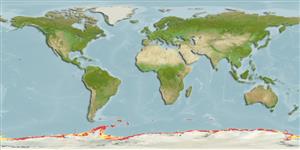Actinopterygii (ray-finned fishes) >
Perciformes (Perch-likes) >
Nototheniidae (Cod icefishes)
Etymology: Trematomus: Greek, trematos = hole + Greek, tomo = section, cut (Ref. 45335); hansoni: Named after Nicolai Hanson, biologist of the Southern Cross Expedition (Ref. 11892). More on author: Boulenger.
Issue
This species is placed in the genus Pseudotrematomus in Eschmeyer (CofF ver. Sep. 2011: Ref. 88002).
Environment / Climate / Range
Ecology
Marine; demersal; depth range 6 - 549 m (Ref. 11892). Polar, preferred 1°C (Ref. 107945); 53°S - 78°S
Southern Ocean: South Orkneys, South Georgia and South Shetland islands. Ross, Davis and Weddell seas, South Victoria, Adelie, Queen Mary and Princess Ragnhild Coasts.
Size / Weight / Age
Maturity: Lm ? range ? - ? cm
Max length : 41.0 cm TL male/unsexed; (Ref. 5179); common length : 25.0 cm TL male/unsexed; (Ref. 2121)
Adults feed on small fishes, krill and other euphausiids, polychaetes, copepods, amphipods, isopods and small gastropods. Mature individuals spawn once a year (Ref. 1071).
Dewitt, H.H., P.C. Heemstra and O. Gon, 1990. Nototheniidae. p. 279-331. In O. Gon and P.C. Heemstra (eds.) Fishes of the Southern Ocean. J.L.B. Smith Institute of Ichthyology, Grahamstown, South Africa. (Ref. 5179)
IUCN Red List Status (Ref. 115185)
CITES (Ref. 94142)
Not Evaluated
Threat to humans
Harmless
Human uses
More information
ReferencesAquacultureAquaculture profileStrainsGeneticsAllele frequenciesHeritabilityDiseasesProcessingMass conversion
Tools
Special reports
Download XML
Internet sources
Estimates of some properties based on models
Phylogenetic diversity index (Ref.
82805): PD
50 = 0.5005 [Uniqueness, from 0.5 = low to 2.0 = high].
Bayesian length-weight: a=0.00490 (0.00281 - 0.00853), b=3.24 (3.09 - 3.39), in cm Total Length, based on LWR estimates for this species & (Sub)family-body (Ref.
93245).
Trophic Level (Ref.
69278): 3.4 ±0.54 se; Based on food items.
Resilience (Ref.
69278): Medium, minimum population doubling time 1.4 - 4.4 years (K=0.22-0.23; Fec = 5,851-12,000).
Prior r = 0.38, 2 SD range = 0.14 - 0.99, log(r) = -0.97, SD log(r) = 0.48, Based on: 3 K, 1 tmax, 9 Fec records
Vulnerability (Ref.
59153): High to very high vulnerability (66 of 100) .
